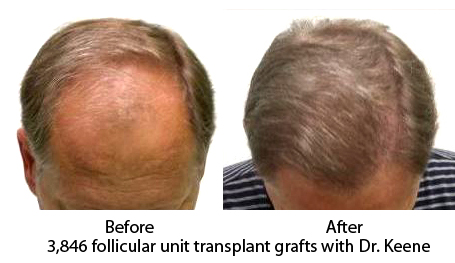
Reality
It’s bad enough that as we age a certain amount of hair is expected to fall out of the head. We all accept that. However, when the hair that is left begins to thin in caliber as well it’s like adding insult to injury. Such was the case for this patient of Dr. Sharon Keene of Arizona.
The Story

BEFORE
He had noticed his hair falling out for years and finally decided it was time to do something about it. Luckily, he found Dr. Keene who was able to evaluate both his current hair loss situation AND his predictable future loss to come up with effective plan. But there was a bit of catch… as there almost always is.

AFTER
Dr. Keene noticed that aside from his advanced hair loss pattern, which is completely normal for his age, that the actual hairs themselves were very fine in caliber. Not just in the balding areas, but in the donor area, too.
A hair transplant can only be as good as the actual hairs being transplanted, and if those hairs are very fine the doctor is faced with a challenge: Should she cover a large area of baldness with a thinner appearance; or, should she cover a smaller area with a thicker appearance ? So much in surgery is a trade off, but as a Board Certified surgeon and experienced hair restoration physician Dr. Keene is used to making such decisions. Her solution was to turn a negative into a positive which is how she consistently produces excellent results.
While thin hair caliber may make it difficult to cover a bald area thickly, such hair is perfect for rebuilding soft and natural looking hairlines. So she included two procedures in her plan. The first was to rebuild the hairline and give some coverage behind. Then she would perform a second procedure to thicken everything up. It clearly worked as she found the perfect balance between a natural look, thickness, and overall coverage.
The Best Part
The kicker here is that she performed this hair transplant using the gold standard procedure known as FUT-follicular unit transplant. This is also known as the Strip method. Like all the top rated doctors in the hair transplant field she had no hesitation showing the donor scar. As can plainly be seen (in the photo below) the skin healed beautifully and all that was left is a thin faded line easily hidden under his hair. The best part is that because she used the FUT procedure all the skin and hair roots above and below her donor scar were untouched and undamaged. So if her patient decided he wanted more hair transplant procedures in the future he can easily have them.

TINY FUT SCAR
Why not FUE ?
While the FUE procedure has achieved a great deal of hype online it is in reality a very limited procedure. The hair growth rates for FUE are simply not as consistent as for FUT and because this patient needed a lot of hair to cover his bald areas with any thickness FUT was the safe and clear choice. The FUE procedure is more traumatic to grafts so should not be used for large sessions. As far as this particular patient he not only had a large area of baldness to cover, but he also possessed a fine caliber hair which typically do not grow well after FUE procedures. Finally, FUE causes more damage to the donor area so that fewer grafts may be obtained for subsequent procedures should he want or need them.
Dr. Sharon Keene has several offices in Arizona.

